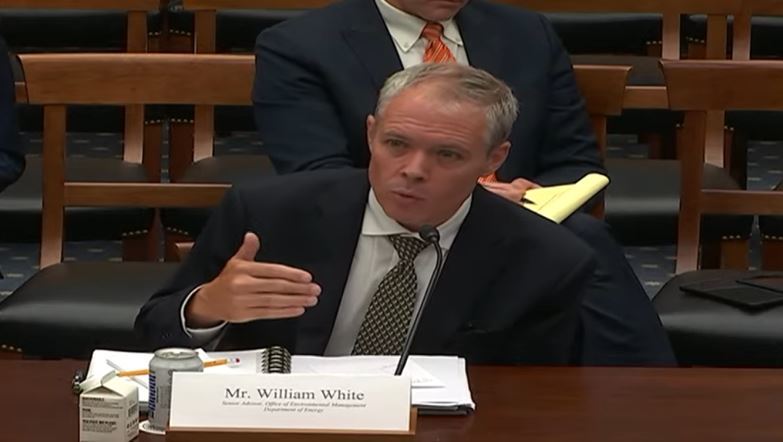|
AIKEN, S.C. – EM and its cleanup contractor at the Savannah River Site (SRS) are employing an innovative method to tackle groundwater cleanup at a former coal-fired power plant in D Area at the site.
Savannah River Nuclear Solutions (SRNS) is using crushed marble (calcium carbonate) to raise the pH levels of groundwater at the power plant site, thereby decreasing the acidity of the water. In chemistry, pH is a measure of water’s acidity. The range goes from 0 to 14, with seven being neutral. pH levels of less than seven indicate acidity.
“Decades of storing coal on the ground in D Area has drastically lowered the pH of the groundwater due to rainwater leaching down through the contaminated soil,” said Kelsey Holcomb, SRNS project manager for area closure projects (ACP). “D Area groundwater pH levels are monitored and average around 3.5, which can be harmful to the environment. We’re taking action to eliminate this potential issue with an innovative, passive solution that will save millions of dollars versus using traditional cleanup methods, such as 'pump and treat.'”
The SRNS environmental cleanup group, Environmental Compliance and Area Completion Projects, has repeatedly introduced successful new environmentally friendly, low-cost and highly effective restoration methods that often harness and use the forces of nature.
“We’re working closely with our regulators on what is, in essence, a large scale experimental study with this new project in D Area,” said Holcomb. “After extensive research, we’re testing our hypothesis and continually analyzing the results. Scientist Ashley Shulland and Design Authority Engineer Eric Schiefer collect and evaluate data to determine system effectiveness and recommend process improvements. ACP also conducts the operation of the system, providing the efficiency of real time feedback.”
Holcomb explained that there are different phases within the project to raise groundwater pH levels to normal.
First, water flowing up and out of a nearby artesian well acts like a tapped spring deep in the Earth; it pushes clean water into a series of injection wells stretched out in a line on the eastern edge of the underground pool of low pH water. The fresh water pushes the affected water westward, where it will naturally surface into a large canal. To date, over 7.3 million gallons of artesian water has been injected.
Next, taking advantage of natural topography, the low pH water flows down a canal where it is intercepted by two 40-foot-long engineered piles of marble stone chips locally purchased in Georgia. When the canal water contacts the marble, a chemical reaction raises the low pH water to an acceptable level.
“DOE and our environmental regulators, the South Carolina Department of Health and Environmental Control and the Environmental Protection Agency, have been extremely supportive,” said Holcomb. “We greatly value their teamwork, partnering to implement new and innovative solutions to protect the environment at the Savannah River Site.”
-Contributor: DT Townsend
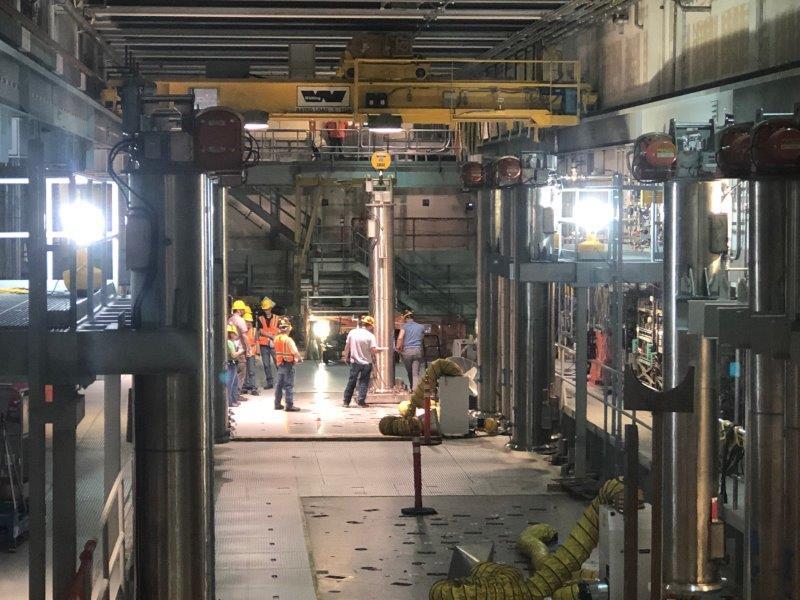 RICHLAND, Wash. – When the Hanford Waste Treatment and Immobilization Plant (WTP) becomes operational and is transforming radiological and chemical tank waste into immobilized glass, a team will periodically replace various parts of the treatment system during routine maintenance. One of those parts will be “bubblers,” which are inserted into the top of two large melters in the plant’s Low-Activity Waste Facility, where waste and other materials are mixed and heated and immobilized, or vitrified, into a glass form. The bubblers send air to the bottom of the melter to stir the 2,100-degree mixture before it is poured into stainless steel containers to cool and then be disposed of at the Hanford Site. Each of the two melters at the Low-Activity Waste Facility will use 18 bubblers at a time during the vitrification process. As part of ongoing proficiency testing, crews recently installed the bubblers, then removed them to test special equipment called a consumable changeout box. The WTP team had worked diligently over several weeks to modify the boxes after identifying ways to improve their design and effectiveness.
-Contributor: Staci West
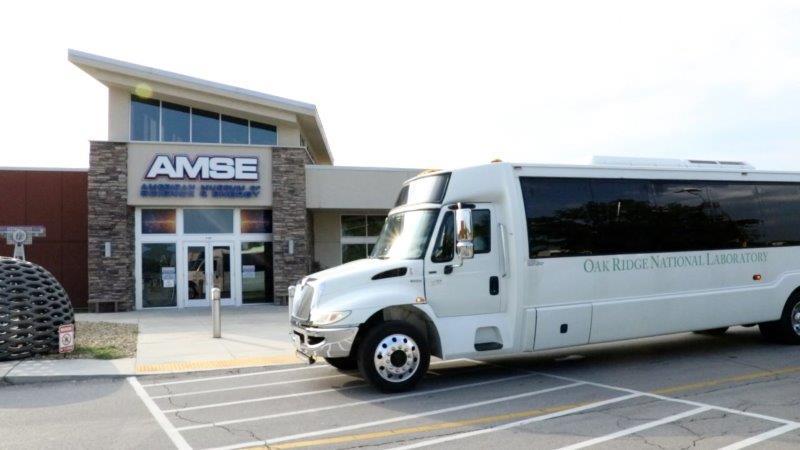 DOE’s public bus tour program at Oak Ridge restarted on July 11 after a two-year pause. Buses depart from the American Museum of Science and Energy for a tour that has attracted tens of thousands of visitors from around the world since 1996.
OAK RIDGE, Tenn. – Some things are worth the wait. After a two-year pause due to the COVID pandemic, DOE’s public bus tour at Oak Ridge officially kicked off a new tour season last week with a new attraction thanks to the Oak Ridge Office of Environmental Management (OREM).
Tours began running again on July 11, and they are scheduled to continue through November. The program is a longtime staple in the community, helping educate residents and visitors about the site’s rich history and current missions. Since it began in 1996, the tour program has attracted tens of thousands of visitors with representation from all 50 states.
 |
|
The bus tour program is a longtime staple in Oak Ridge. Since it began in 1996, it has attracted visitors from all 50 states. |
Matt Mullins, marketing and communications director for the American Museum of Science and Energy in Oak Ridge, discussed what draws visitors regionally and nationally. The museum is the departure point for the bus tour.
“You see where that big science happened, and you realize in those three small facilities the fate of the world shifts. The small secrets that Oak Ridge held to themselves have gone public, and on this tour, you get to see where that action really happened,” Mullins said.
The three-and-a-half-hour tour allows visitors to see all three DOE sites on the Oak Ridge Reservation, including Oak Ridge National Laboratory (ORNL), Y-12 National Security Complex, and East Tennessee Technology Park.
This year’s tour will be the first to feature the newly constructed K-25 History Center. The facility, an OREM project, opened only weeks before the COVID pandemic began. It offers 250 original artifacts on display. Nearly 1,000 oral histories were collected from former Manhattan Project and Cold War-era workers that museum professionals used to develop the exhibits and interactive galleries inside.
 A rendering of the historic preservation related projects the Oak Ridge Office of Environmental Management is slated to complete at the East Tennessee Technology Park in coming years. The K-25 History Center, right, is already open to visitors.
OREM is currently advancing plans to complete its historic preservation commitments, which includes constructing the K-25 viewing platform and wayside exhibits around the K-25 Building.
Among the other stops, visitors on the bus tour go inside the Graphite Reactor at ORNL. The national historic landmark is a key component of the Manhattan Project National Historical Park. It houses the world’s oldest reactor and served as the pilot plant that led to the first production of plutonium.
-Contributor: Ben Williams
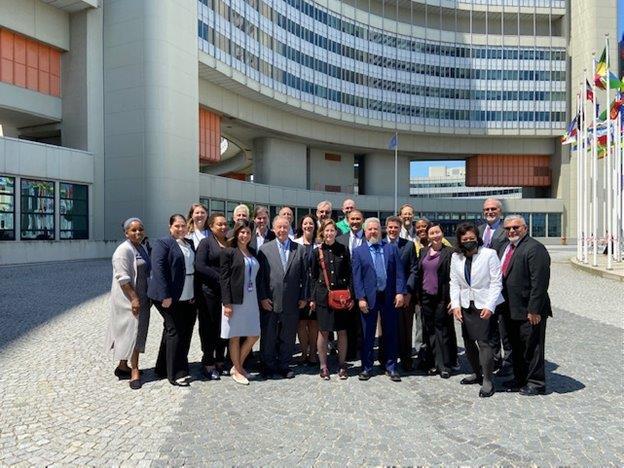 The U.S. delegation at the 7th Review Meeting of the Parties taken outside the International Atomic Energy Agency headquarters in Vienna.
VIENNA – For more than two decades, EM has provided technical leadership to the U.S. government’s interagency working group implementing the Joint Convention, an international treaty on the safety of spent fuel management and radioactive waste management. The treaty, adopted in 1997, marked its 25th anniversary this year.
Over 700 delegates representing 76 of the 88 Contracting Parties across the globe participated in the Seventh Review Meeting of the Joint Convention, held June 27-July 8 in Vienna.
Patricia Metz, deputy director of the Office of Nuclear Energy, Safety and Security at the Department of State, led the U.S. delegation composed of experts from the National Nuclear Security Administration, DOE program offices, the Nuclear Regulatory Commission and the Environmental Protection Agency. EM delegates included Julia Donkin, Jomaries Rovira and Doug Tonkay.
Rafael Mariano Grossi, director general of the International Atomic Energy Agency (IAEA), welcomed the delegates and highlighted the current war in Ukraine, a country with nuclear power where IAEA experts are assisting with technical assessments, disposal of disused orphan sources and safe transport of radioactive sources. The U.S. and several other delegations submitted statements regarding the impact of military actions on the ability of Contracting Parties to meet treaty obligations. The U.S. statement was read as part of the U.S. national presentation.
 Doug Tonkay makes a presentation on July 4, during a session on stakeholder engagement at the Joint Convention meeting.
Tonkay was among the U.S. delegates who delivered the U.S. national presentation, which highlighted significant progress despite the pandemic, since the last national report was issued in 2019. U.S. experts also participated in peer review sessions of all country groups.
Tonkay also discussed EM stakeholder engagement efforts as part of a program that also included participants from Argentina, Australia, Canada, France, Germany, South Africa and the United Kingdom. Delegates showed particular interest in EM activities, such as its citizens advisory boards, efforts in environmental justice and engagement with tribal nations.
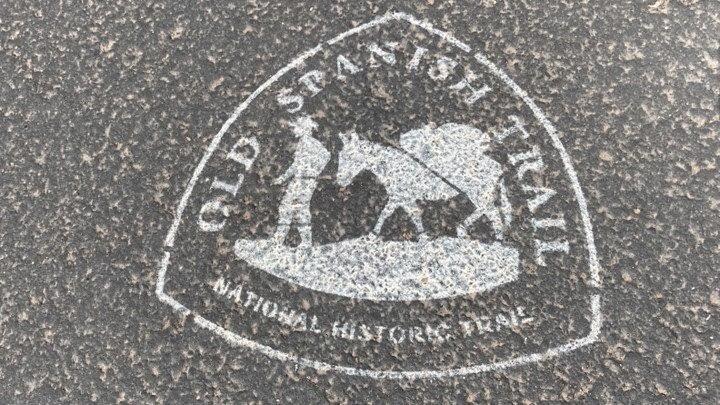 The official Old Spanish Trail logo is stamped on “silhouettes” commemorating the historic trail.
MOAB, Utah– It’s said that history is all around us, and evidence of that was made plainly visible at the Moab Uranium Mill Tailings Remedial Action (UMTRA) Project this summer when the project collaborated with a local nonprofit to commemorate the historic Old Spanish Trail.
The Canyonlands Back Country Horsemen had approached DOE with a desire to memorialize the Old Spanish Trail in Moab, part of the National Historic Trails system. Since the original trail crosses a portion of land owned by the Department, a legal agreement was finalized this spring allowing the group to access the property, which is offsite from the Moab UMTRA Project.
The monuments that the group employed to commemorate the trail are sculptures referred to as “silhouettes” cut from heavy grade metal, and measuring approximately 6-7 feet high and 4-5 feet long. Two of the four silhouettes are cutouts of mules with packs on their backs, while the other two depict individuals riding horses.
The silhouette designs were chosen to accurately represent the travelers along the Old Spanish Trail, which because of its terrain only allowed for pack animals like horses, mules and donkeys. Wagons were unable to get through the deep canyons, steep hills, rivers, and rocky, sandy land that made up this trail system.
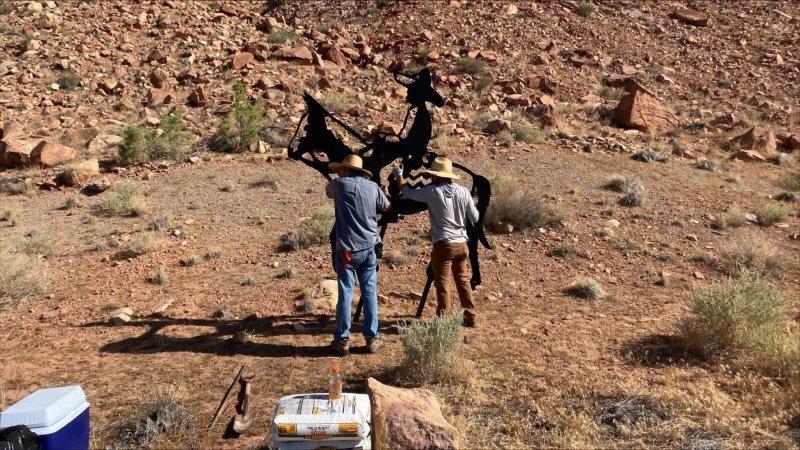 |
|
Members of the Canyonlands Back Country Horsemen group help place one of the art silhouettes. |
Four art silhouettes were installed along the historic Old Spanish Trail near Moab. |
|
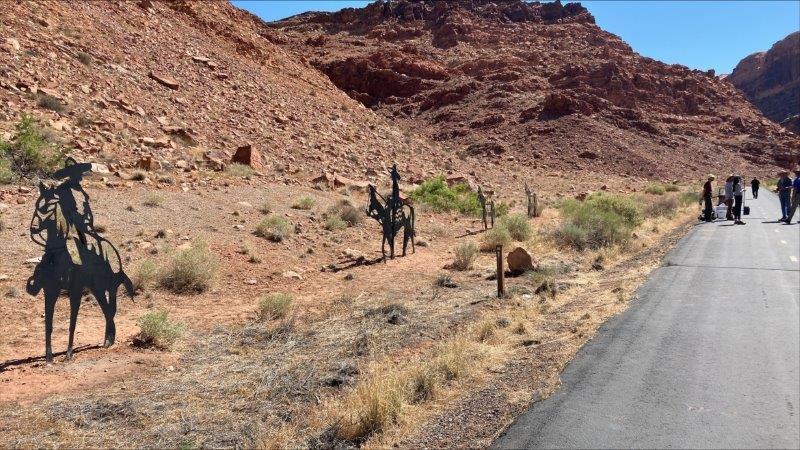 |
Memorializing this portion of the Old Spanish Trail was especially important to the Canyonlands Back Country Horsemen. Director Steven Schultz said the Moab stretch of the trail was vital to travelers because it allowed them to cross the Colorado River more easily. Cliffs border the river for hundreds of miles in either direction, so the Moab location provided weary travelers a respite because they could cross on foot.
“Moab was essentially created because of this trail, and it is now a town full of trails,” Schultz said. A current count estimates that there are at least 277 Moab trails. The creation of the Old Spanish Trail helped launch the area into the 20th century, which now is home to the renowned Arches National Park.
-Contributor: Barbara Michel
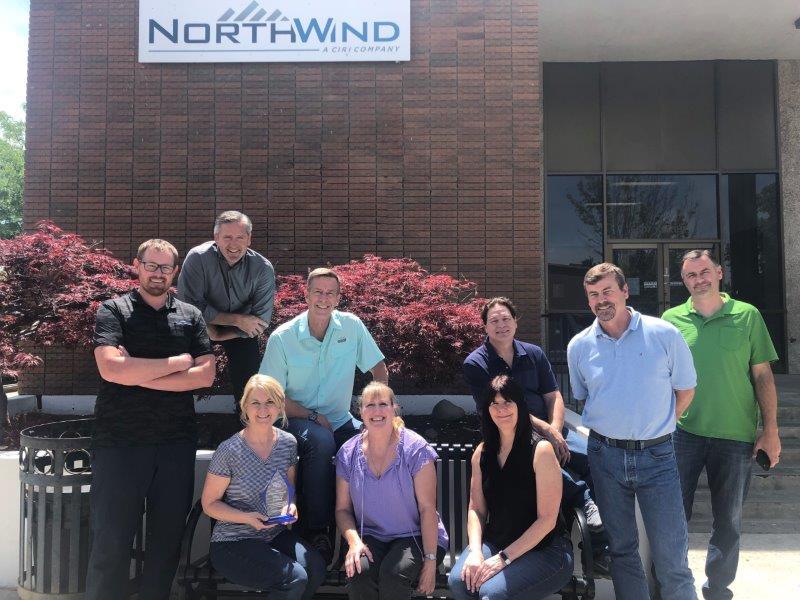 A Hanford Mission Integration Solutions subcontractor, North Wind Solutions, plans to continue providing support for the One Hanford mission in information technology services, cybersecurity and records management. From left, back row, are Bryson McCartney, Thom Holder, Rick Moren, Pete Baccetti, Tim Logan and Jason Smith; from left, sitting, are Rose Nipper, Bonnie Martin and Kat Waterbury.
RICHLAND, Wash. – The Tri-City Regional Chamber of Commerce recently presented a “Business on a Roll Award” to the team responsible for information technology services, cybersecurity and records management at the Hanford Site.
The award was presented to North Wind Solutions, a subcontractor to EM contractor Hanford Mission Integration Solutions (HMIS), which provides infrastructure and site services necessary to accomplish environmental cleanup at the site.
“The HMIS team, including North Wind Solutions, continues to drive performance improvements, keeping the site’s information secure from outsiders, yet accessible to all contractors that support the One Hanford cleanup mission,” said Tim Haddick, EM director of the Security, Emergency Services and Information Management Division.
North Wind has supported the Hanford Site for more than 20 years, and the Richland team recently celebrated a milestone of 750,000 safe hours worked. Another noteworthy accomplishment was hiring 330 employees in a matter of days as part of the transition of the Hanford Mission Essential Services Contract in early 2021. These achievements contributed to the “significant business success” noted by the chamber’s Regional Awards and Recognition Committee in selecting North Wind following a “meaningful year of growth that contributes to a strong and vibrant business community.”
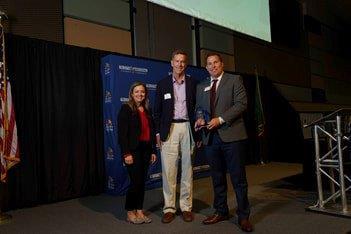 |
|
Tri-City Regional Chamber of Commerce Board members Andy Stirling, right, and Trish Herron, left, presented the “Business on a Roll Award” to Rick Moren, center, senior program manager for the North Wind Solutions Hanford-Richland Office. |
“We are pleased to work with HMIS and DOE in safely and successfully executing, maintaining and defending the Hanford information management infrastructure and maintaining records across the entire site,” said Rick Moren, senior program manager for the North Wind Solutions Hanford-Richland Office.
A video played during the award ceremony highlighting North Wind Solutions accomplishments in the past year.
-Contributors: Anne Smith, Robin Wojtanik
|


